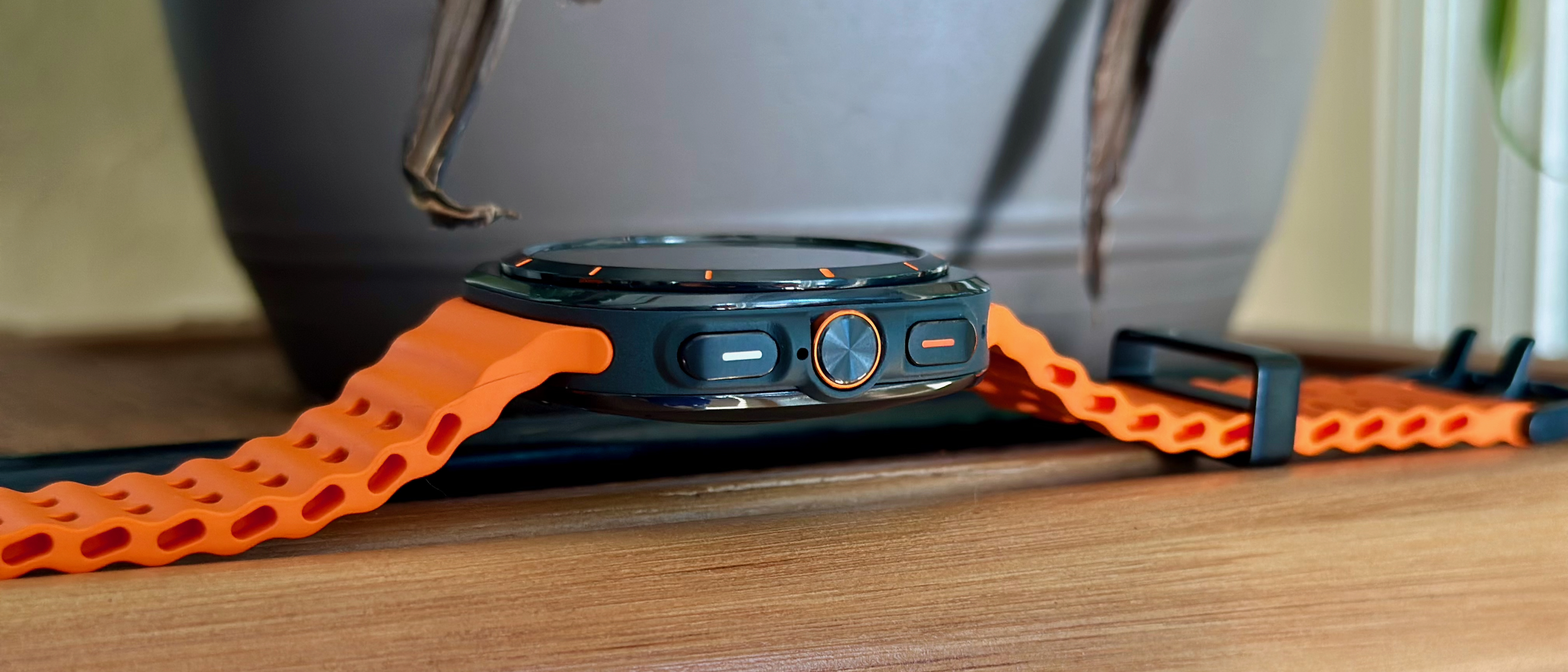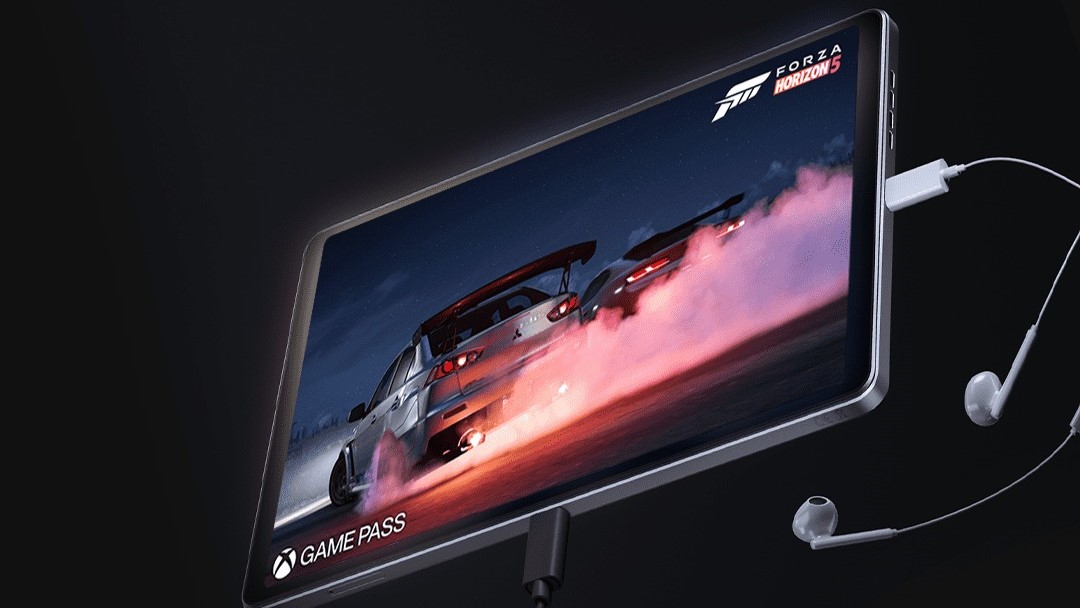Android Central Verdict
The Samsung Galaxy Watch Ultra is a fantastic smartwatch, with accurate health data, fast performance, plenty of app and music storage, and a vivid display. It also had a very high bar to clear to live up to its "Ultra" name and high price tag, and those with a Pro or Classic watch may not like every decision Samsung made with it. But the more time we spend with it, the more impressed we are with the design and battery life.
Pros
- +
Striking design makes a real impression
- +
Bright, protected display
- +
Noticeable Exynos & battery boost
- +
Revamped heart rate accuracy
- +
Dual-band GPS comparable to Garmin
- +
Built-in LTE support
Cons
- -
Should've had a proper crown
- -
Too heavy, thick for some wrists
- -
New AGEs Index isn't ready for primetime
Why you can trust Android Central
Whether the Samsung Galaxy Watch Ultra blows you away or disappoints you will depend entirely on context and expectations. Galaxy Watch 5 Pro owners might have hoped for more battery life, while Watch 6 Classic users probably dislike the design choices Samsung's engineers made. Apple fans will scoff at the similarities to their Ultra watch, while Pixel Watch fans may be jealous of the premium features.
If you ignore the fact that Samsung cribbed upgrades like the third Quick Button, siren, and 3,000-nit display from Apple and look at this device in a vacuum, the Galaxy Watch Ultra is a fantastic smartwatch that has grown on me after six weeks of testing. I've become accustomed to its weight, its design makes my other smartwatches look cheap, and its fitness performance surpassed my expectations.
Most importantly, Samsung patched a serious issue with the Galaxy Watch Ultra and Galaxy Watch 7 a few weeks after launch. During my initial review, the battery drained so quickly that I found it hard to recommend paying so much for so little upside. Now, it more than lives up to Samsung's battery estimates, and that made me bump my review score up a half-star.
So even though many people saw pictures of the Ultra and wrote it off as ugly or a weird Apple clone, I'd advise you to take it seriously—if you can afford it.
I can't wave away the simple fact that this watch costs more than the Pro and Classic that preceded it, and even if the Galaxy Watch Ultra is one of the best Android smartwatches today, not everyone needs to spend so much money on a watch. So let's dive in and help you decide if you're ready to splurge on the Ultra!
Samsung Galaxy Watch Ultra: Price and availability
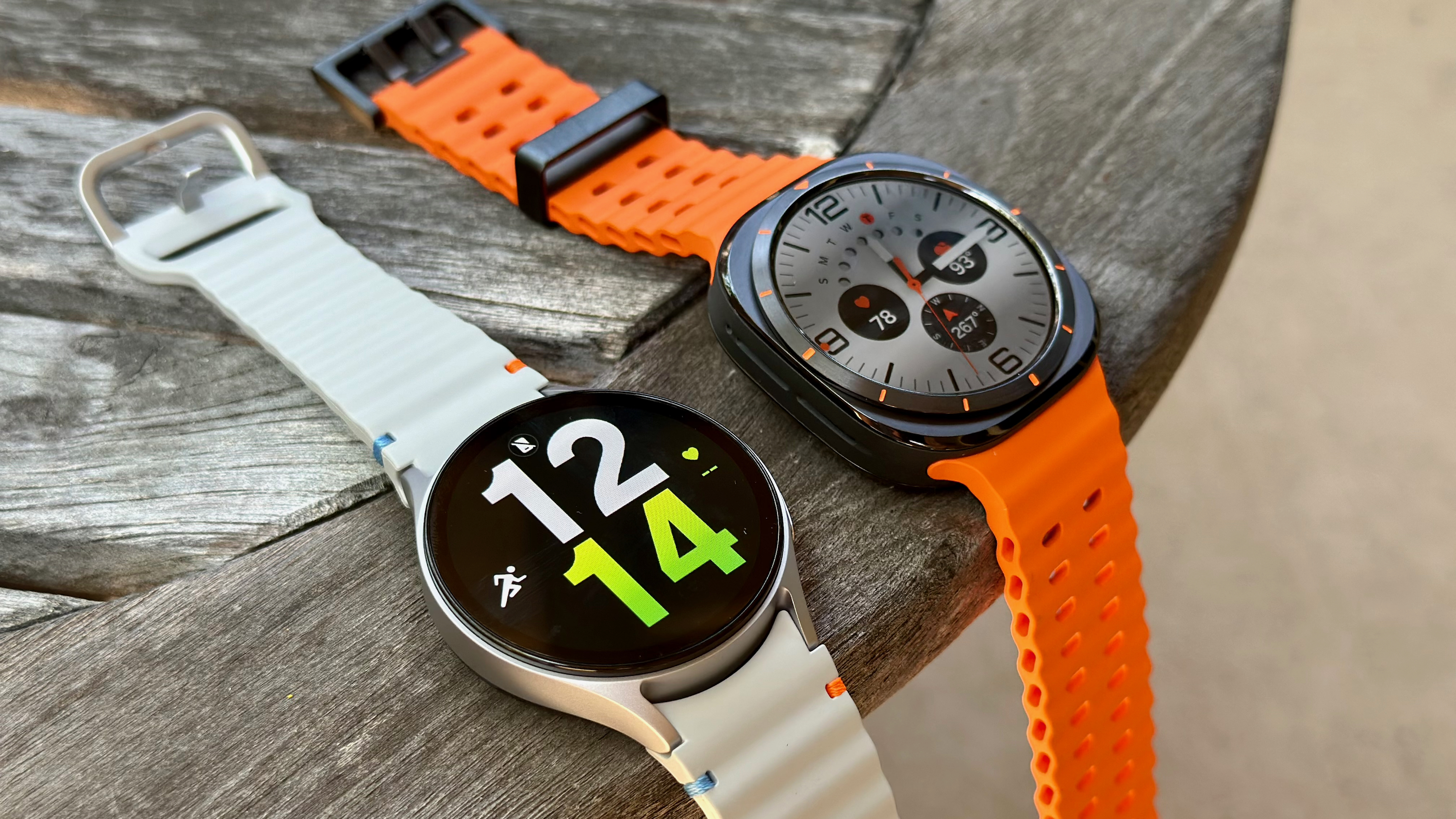
Samsung released the Galaxy Watch Ultra on July 24, 2024, for $649 / £599 / €699 / CA$879 / A$1,299 / ₹59,999. By contrast, the 44mm Galaxy Watch 7 with the same display size costs $329, or about half the price.
Available in White, Silver, and Black, the Galaxy Watch Ultra has three band options: Marine, Trail, and Peakform. Each costs $79 as a standalone option if you choose to buy a second option. The nylon Trail band is the lightest for the best comfort but will absorb sweat. The elastomer Marine band repels water for swimming and water sports but feels the heaviest. The rubber Peakform band is a sporty middle ground option.
As of late August, Samsung offers a significant trade-in discount for the Galaxy Watch Ultra on Samsung.com. While they vary by country, in the U.S., you can get up to $350 off with a Galaxy Watch 6 Classic or Watch 5 Pro. I'll include some of the trade-in values below:
- $350: Galaxy Watch 6 Classic, GW 5 Pro, Apple Watch Ultra / Ultra 2
- $300: GW 4 Classic, AW Series 9 / 8
- $250: AW Series 7 / 6, Garmin Forerunner 965 / 955 Solar
- $200: GW 6 / 5, AW Series 5
- $175: Garmin Venu 3, Forerunner 265
- $150: GW 4 / 3, AW SE (2), Garmin Instinct 2 / Crossover, Forerunner 255
- $100: Any smartwatch in good condition
Samsung Galaxy Watch Ultra: Design and bands

- Despite being heavier and thicker than most watches, you get used to the Ultra's weight.
- The Marine band is comfortable and balances the Ultra's weight and look well, while the Trail is better suited for workouts.
- The Quick Buttons is very useful but should have been a crown.
- While durable, the Ultra has had a few quality control issues since launch.
Samsung designed a watch that looks better in person than in photos. All you can see from afar is a chunky square; in person, the shiny, metallic contours and buttons, rounded edges, and raised bezel look attractive and distinct from any other smartwatch I've worn.
Without a band, the Galaxy Watch Ultra weighs 60.5g / 2.13oz, comparable to the Watch 6 Classic 47mm (59g) but heavier than the Watch 5 Pro (46.5g). Unlike the Classic, most of that extra weight is for squircle aesthetics, not the function of a rotating bezel. Switching to this will be a real transition if you're used to the 1.5-inch Watch 6 (33.3g), though not compared to other "flagship" watches.
Still, this thing is chunky. Samsung claims it's 12.1mm thick, not including the massive health sensor lump; I measure it as closer to 16mm thick.
Despite its thickness and weight, I've grown accustomed to the size and don't find it as uncomfortable as I first did. Also, even though I hate wearing a smartwatch to bed, I'm pleasantly surprised to find that it wasn't terrible to wear for sleep tracking across several nights of testing. My Marine band keeps it feeling loose and breathable.
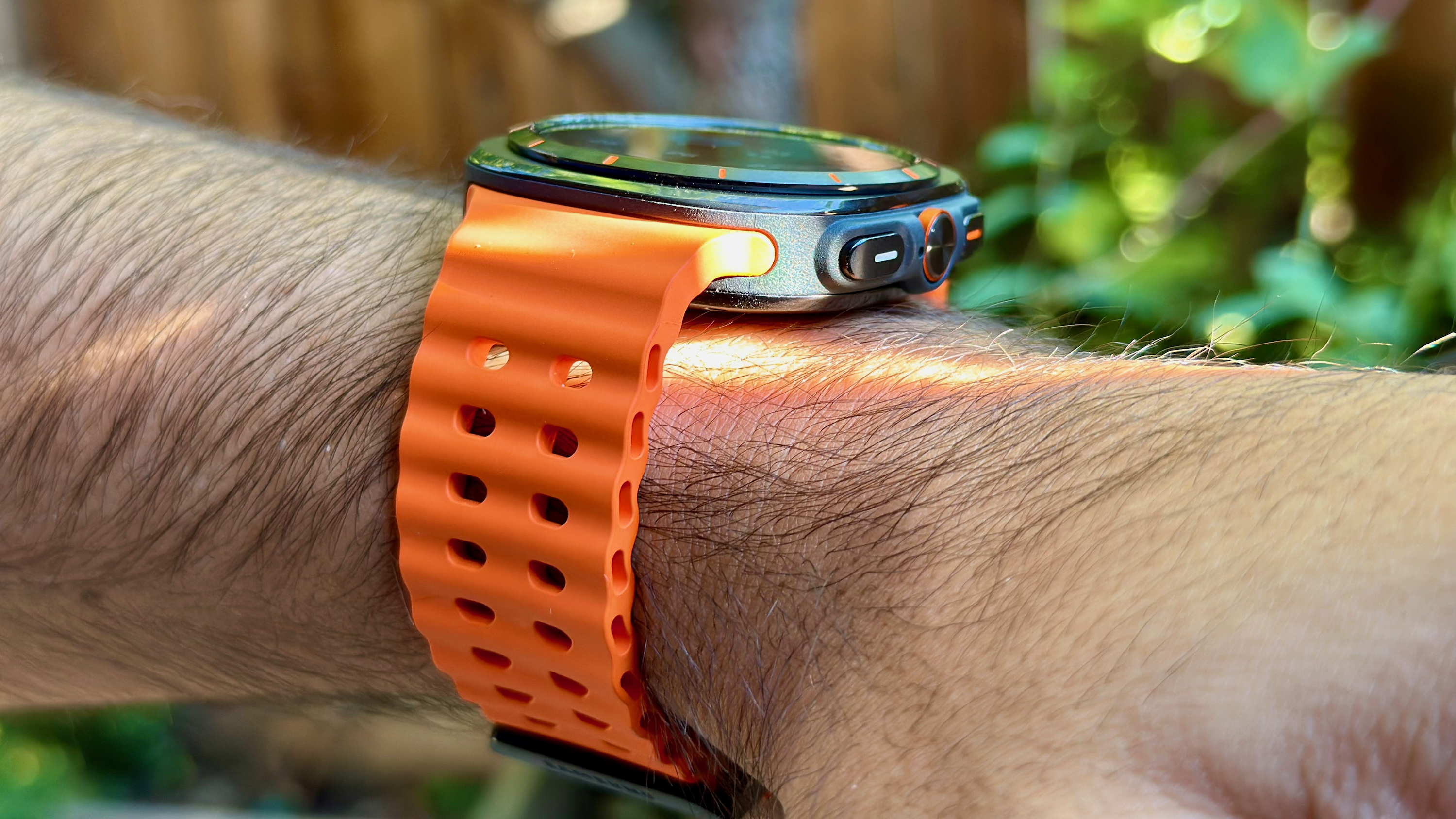
I enlisted my smaller-wristed, Apple Watch Series 9-wearing fiancee for her opinion, having her wear the Galaxy Watch Ultra and Apple Watch Ultra 2 on either wrist. She said she'd happily wear either but that she preferred the Galaxy Watch Ultra's design and the fit of the Marine band over Apple's Trail band, which she said made it look and feel "top-heavy."
Though I find the Marine band quite thick and would've preferred the thinner nylon option, it proportionally matches the Galaxy Watch Ultra's bulk, so the weight distributes more naturally, and it appears less oversized. I don't mind an imbalanced, blocky look for a softer, more breathable band, so I'd have chosen Trail or Peakform myself.
I've since supplemented Samsung's main band with third-party Galaxy Watch Ultra bands that cost significantly less. Samsung's Dynamic Lug system is proprietary and doesn't work with your old Galaxy Watch bands, but at least it's incredibly easy to use. Tap two buttons along the Ultra's bottom to pop out both straps, then slide and click the new bands in. Once you know what you're doing, it takes less than a minute.
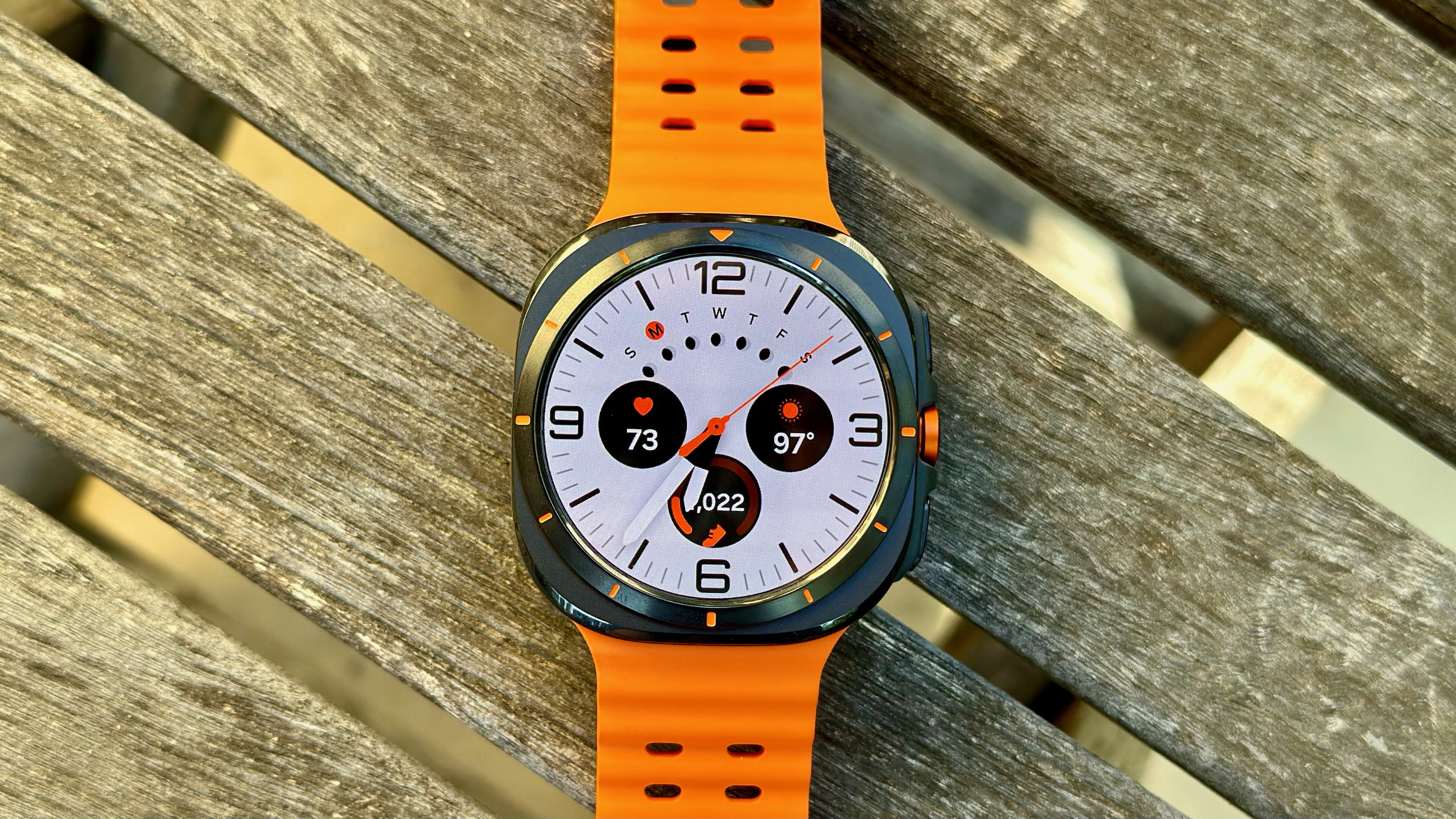
What makes the Galaxy Watch Ultra "niche" is its rugged design, which is tailored for extreme conditions. All Samsung watches have the MIL-STD-810H label slapped on, meaning they should survive if dropped on the floor. Samsung specifically tested the durable Ultra for "high/ low temperatures, altitude, humidity, immersion, salt, fog, dust, vibration, and drops."
The Galaxy Watch Ultra can survive elevations up to 29,527 feet, or slightly higher than Mount Everest. Of course, it's only rated for temperatures of -4°F to 131°F (-20ºC to 55ºC) before functions fail, and most mountain peaks get much colder than that. Ultra users will probably wear it in more casual workout conditions.
Samsung promises that the Galaxy Watch Ultra has 10ATM water resistance (double most watches' max depth) and was tested in salty or chlorinated water. Thus, you can safely swim anywhere or use it for high-speed water sports, as long as you gently rinse and dry it off afterward.
Unfortunately, since launch, we've seen a couple of Ultra buyers complaining about misaligned displays or the Quick Button falling off, with Samsung customer support reportedly refusing to step in in one case. It reminds me of the issues with the Pixel series' volume rocker falling off, and it's my one vague concern with the Ultra's design — that it may run into durability issues and that Samsung's QC won't be as responsive as you'd expect for such an expensive device.
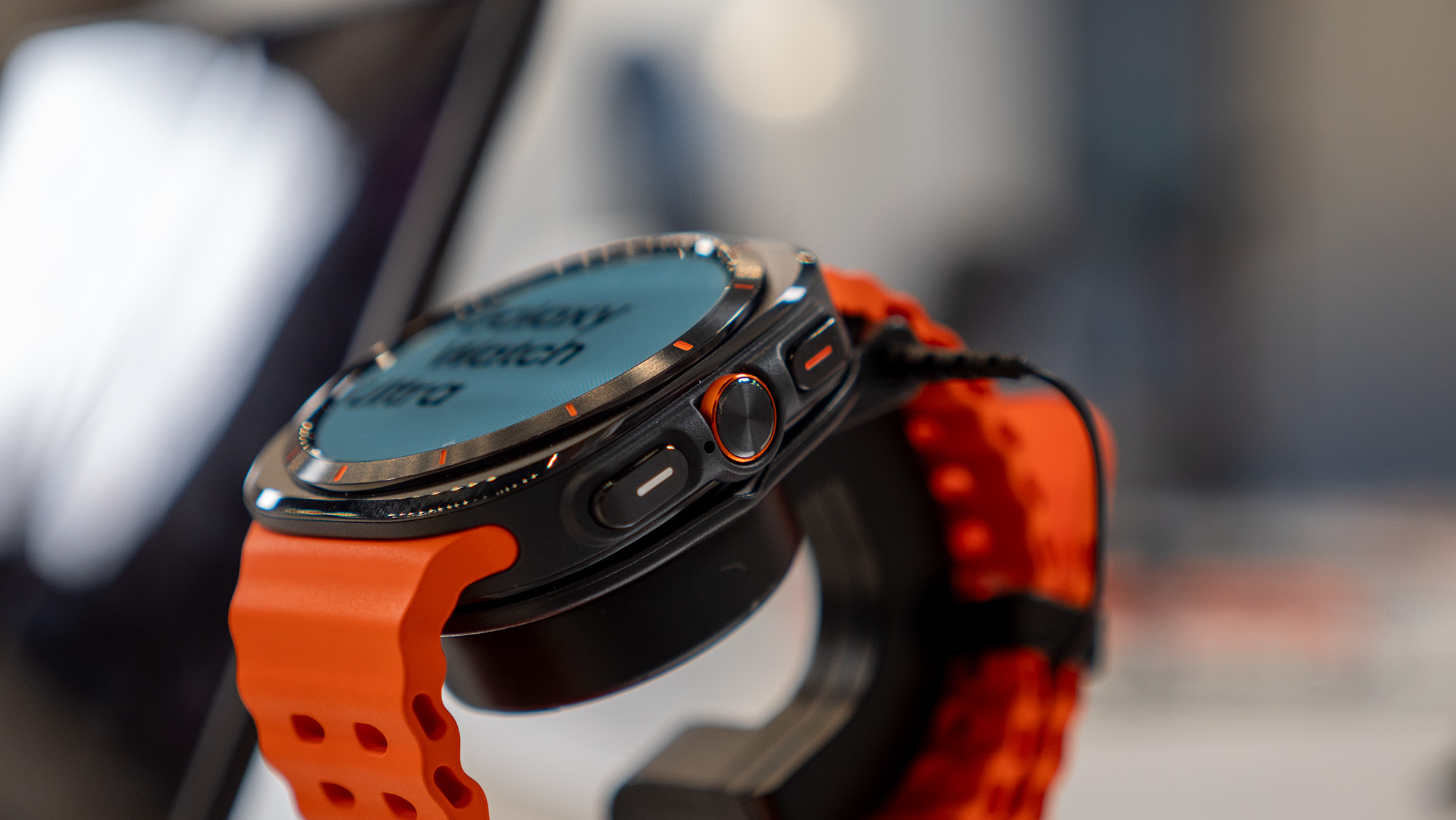
The Quick Button, nested between the usual two Home and Back buttons, opens up your Samsung Health exercises by default, though you can reconfigure it to trigger your flashlight, stopwatch, or water lock mode. Hold it down, and you'll trigger an 85db siren to help people find you in emergencies. It's uncomfortably loud in practice, which is the point in emergencies!
During a workout, you tap the Quick Button to pause the activity instantly instead of having to swipe left and tap a button with sweaty fingers. It's extremely convenient, the main thing I'd miss as a runner if I downgraded to the Galaxy Watch 7.
My main complaint is that Samsung made the Quick Button crown-shaped but didn't add any crown functionality. Without the Watch 6 Classic's physical bezel, you're fully reliant on swipes or rotating your finger along the display edge to scroll, and I much prefer a physical dial since that leaves my view of the display uninterrupted. Without a crown or bezel, the Ultra experience is missing something.
Samsung Galaxy Watch Ultra: Hardware and display
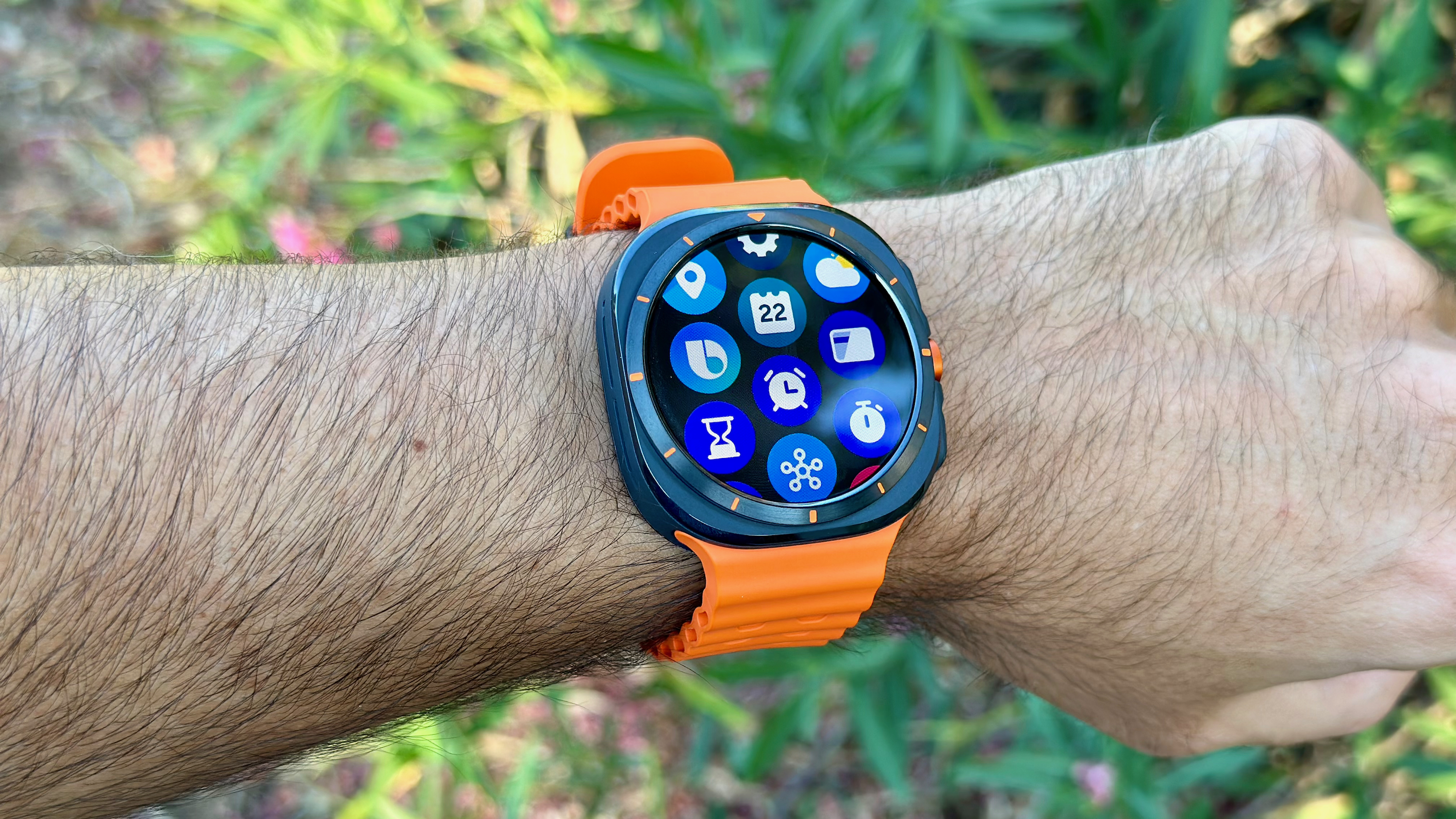
- The Galaxy Watch Ultra has a new Exynos W1000 CPU with a faster clock speed and more cores than the Watch 6's Exynos W930.
- It has the same RAM as last gen but double the storage.
- The display is the same size (but brighter) than the Watch 7's.
Samsung gave the Galaxy Watch Ultra and Galaxy Watch 7 44mm the same 1.5-inch, 480 x 480 display with about 320 pixels per inch, except that the Ultra hits 3,000 nits of brightness instead of 2,000. That extra brightness looks fantastic in direct California sunlight, richly colorful and unimpeded by reflections.
It has Sapphire glass to protect against scratches and an elevated bezel that makes the display less likely to scrape against something than the fully flat Watch 7.
You might wish Samsung had made the Ultra display even larger to justify the higher price, but it's already heavy enough. Maybe Samsung will transition the Galaxy Watch Ultra 2 to a squircle, as has been rumored, to differentiate the Ultra from mainline Galaxy Watches. For now, Samsung has made the right call by keeping things familiar to long-time Android watch fans.
| Category | Samsung Galaxy Watch Ultra |
|---|---|
| Display | 1.5-inch Super AMOLED, 480 x 480, 3,000 nits |
| Colors | Titanium Sliver, Titanium Gray, Titanium White |
| Processor | Exynos W1000 (1.6GHz) |
| RAM & storage | 2GB + 32GB |
| Battery | 590mAh |
| Software | One UI 6 Watch (Wear OS 5) |
| Sensors | Samsung BioActive Sensor (Optical Heart Rate + Electrical Heart Signal + Bioelectrical Impedance Analysis), Temperature Sensor, Accelerometer, Barometer, Gyro Sensor, Geomagnetic Sensor, Light Sensor |
| Dimensions | 47.1 x 47.4 x 12.1mm* |
| Weight | 60.5g |
| Connectivity | LTE, Bluetooth 5.3, WiFi 2.4/5GHz, NFC, GPS (L1+L5), Glonass, Beidou, Galileo |
| Durability | 5ATM + IP68, MIL-STD-810H, Sapphire Glass |
| Price | $649 |
The Galaxy Watch Ultra and Galaxy Watch 7 have nearly identical hardware. The four main Watch 6-to-7 upgrades — the Exynos W1000 CPU, doubled storage, dual-band GPS, and 3x the LEDs for better heart rate data — are found on both watches. I'm glad Samsung didn't keep these new perks exclusive to try and upsell us, but that does mean the Ultra doesn't have that many exclusives besides extra battery life and built-in LTE cellular through your carrier.
That doesn't make these upgrades any less valuable. I'll talk in a later section about the excellent GPS and HR performance, and the doubled storage is vital for anyone who wants to stream music, podcasts, or audiobooks while using the Watch Ultra as a standalone smartwatch.
As for the Exynos W1000 upgrade, Samsung's marketing claims that it's "2.7x quicker" than the last-gen Exynos W930. That had just two Cortex-A55 cores clocked at 1.4GHz, while the newer CPU has four Cortex-A55s clocked slightly higher (1.5GHz) and one Cortex-A78 (1.6GHz).
In real-life use, it's undoubtedly faster than my Watch 6 and (especially) Watch 5 Pro, loading apps and processing Google Assistant queries in a flash. I wouldn't say the Galaxy Watch Ultra is 2.7x faster, as the Watch 6 was already quite fast. But you see far less lag, and the extra cores will handle demanding tasks for future Wear OS feature updates. I have no complaints.
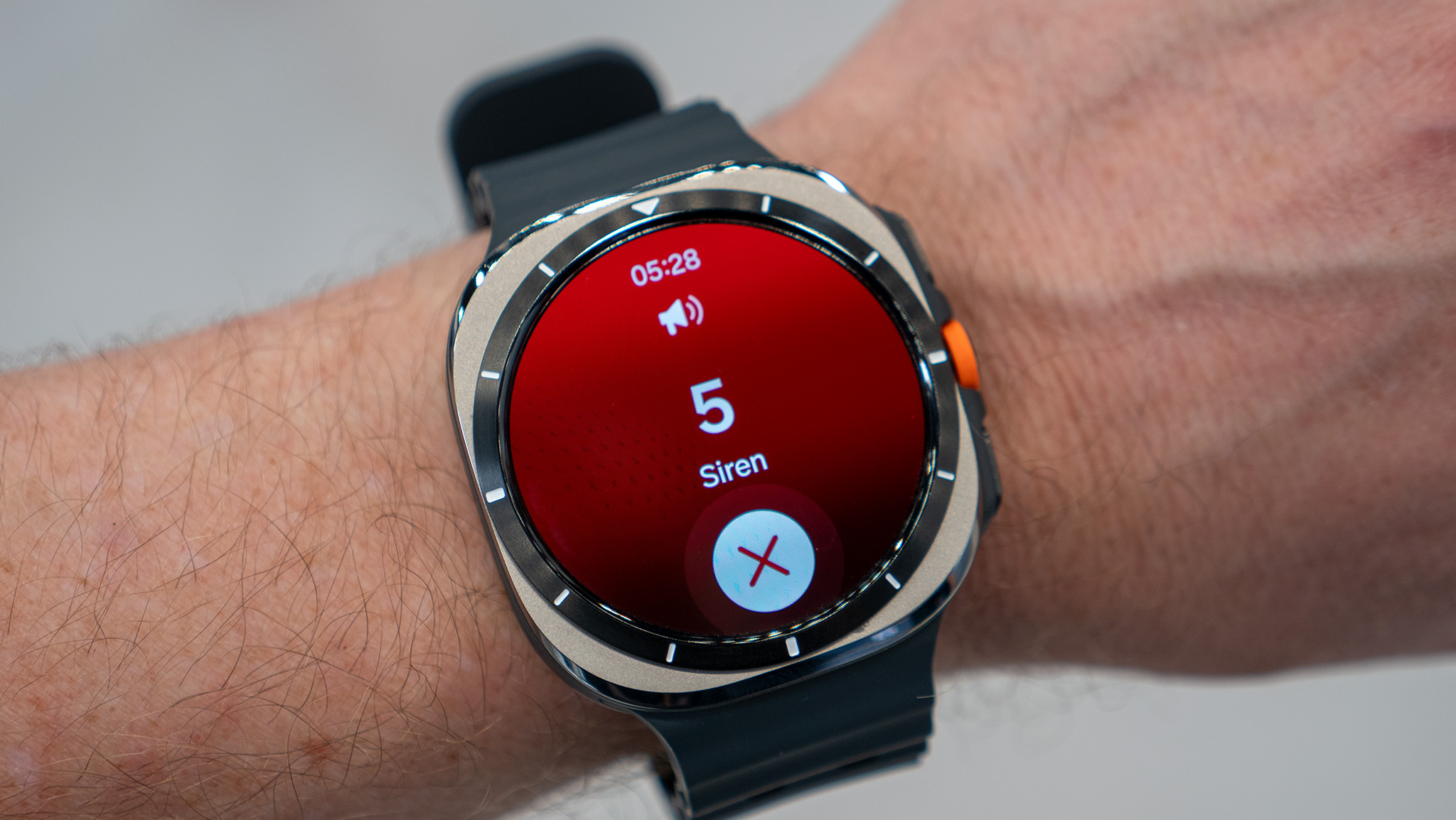
Otherwise, if you compare the Galaxy Watch 6 vs. 7 and Ultra for hardware, Samsung didn't change anything significant with its connectivity standards or sensor array, aside from the siren and "free" LTE.
I'll admit that I didn't test the Ultra's LTE features. I don't care much about standalone LTE features, and I suspect plenty of Ultra buyers will let the LTE functions go unused because the setup is a hassle and the carrier add-on cost is surprisingly expensive. Google recently launched the Pixel Watch 3 and offered two free years of data for anyone who upgrades to an LTE model; I really wish Samsung had done the same with the Galaxy Watch Ultra.
Samsung Galaxy Watch Ultra: Battery and charging

- Samsung promises 60 hours of battery life with the always-on display active or 100 hours in power saver mode.
- While the Ultra had a battery drain issue at first, Samsung fixed it with a post-launch update.
- It takes about two hours to recharge.
During my initial Galaxy Watch Ultra review, I warned would-be Ultra buyers that it didn't live up to Samsung's battery promises. It only tended to last about 40 hours with AOD, so I knew I'd have to charge it before a second night of sleep tracking. The battery drain was painfully noticeable.
Thankfully, Samsung patched whatever caused this rapid draining, and the Ultra has more than lived up to its on-paper promises since then. At the moment, it's been 60 hours since I last charged it, and the battery is at 21% despite two nights of sleep tracking and two hours of dual-band GPS tracking. It could probably make it a third night, but I'm charging it to be safe.
Without AOD, the Galaxy Watch Ultra is among the longest-lasting Wear OS watches, competing with the TicWatch 5 Pro Enduro and OnePlus Watch 2 — though both watches cost half as much.
As for fitness tests, I found the Galaxy Watch Ultra used about 15% battery across two hours of GPS-tracked workout time, before and after the patch. That would put it on pace for 13 hours of tracking, which is slightly below estimate but more than enough for an all-day workout with enough juice left for sleep tracking.
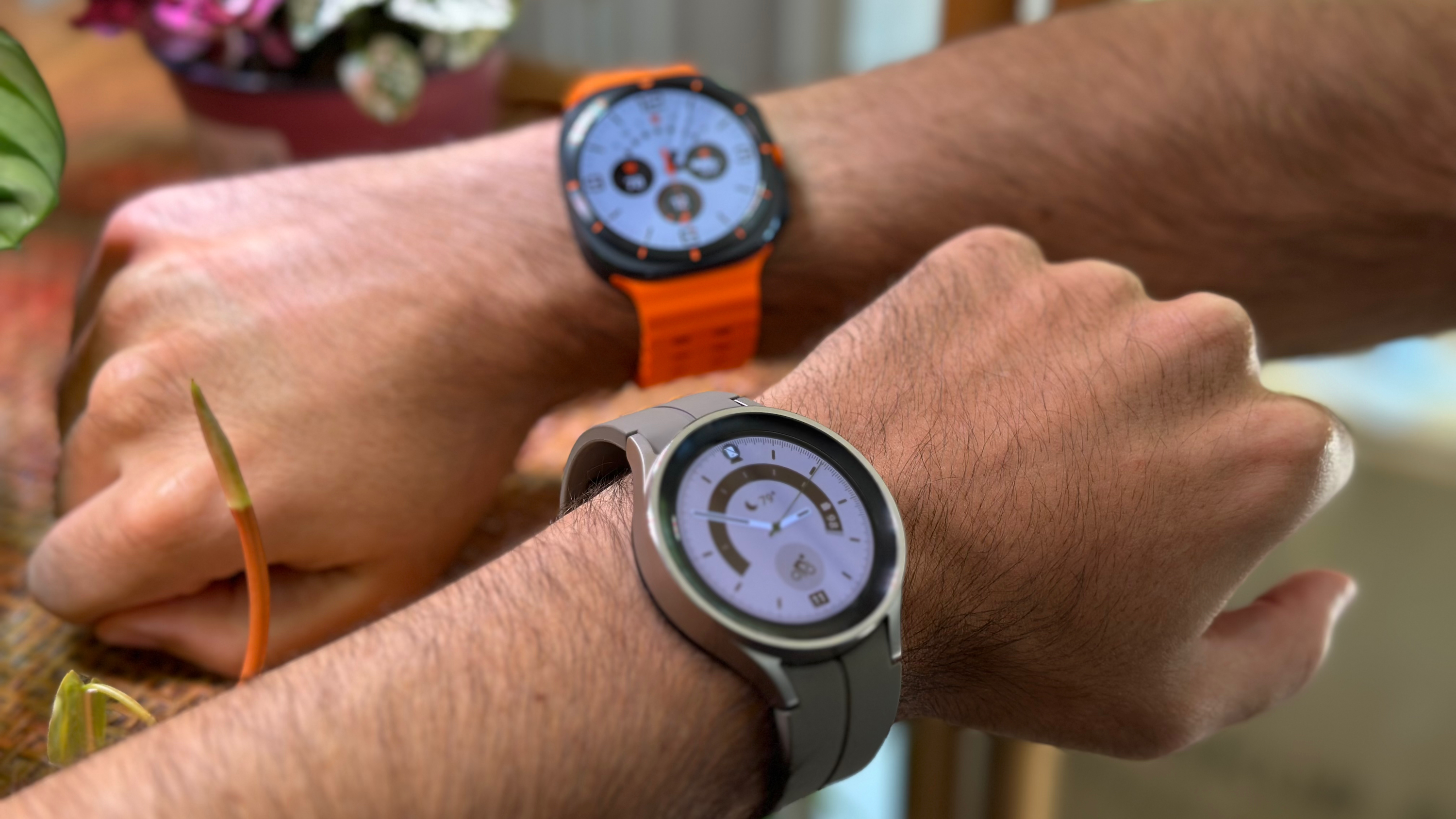
Samsung gave the Galaxy Watch 5 Pro and Watch Ultra the same 590mAh capacity, and it's fair to wish that Samsung had found more room for a little extra capacity this time, given the Ultra's weight gain. The Watch 5 Pro had equal longevity two years ago but naturally lost some of its endurance since then; that means the Ultra will provide a boost, but also that it may not last as long as we'd hope.
As for charging speed, it'll depend on your charging adapter. I've seen conflicting reports on whether this series uses 10W or 15W, but practically speaking, it usually takes me about two hours to refill the Ultra from low battery to 100%. That's not as fast as you might like, but slower charging usually corresponds with better battery health over time.
Samsung had to redesign the charging puck a bit because of changes to the health sensor, which means the Galaxy Watch Ultra and Watch 7 no longer support Wireless PowerSharing from your Samsung phone. I never took advantage of this feature myself, but our Watch 7 reviewer called this a "small bummer" for "forgetful folks" who liked topping off their watch away from home.
Samsung Galaxy Watch Ultra: Fitness accuracy
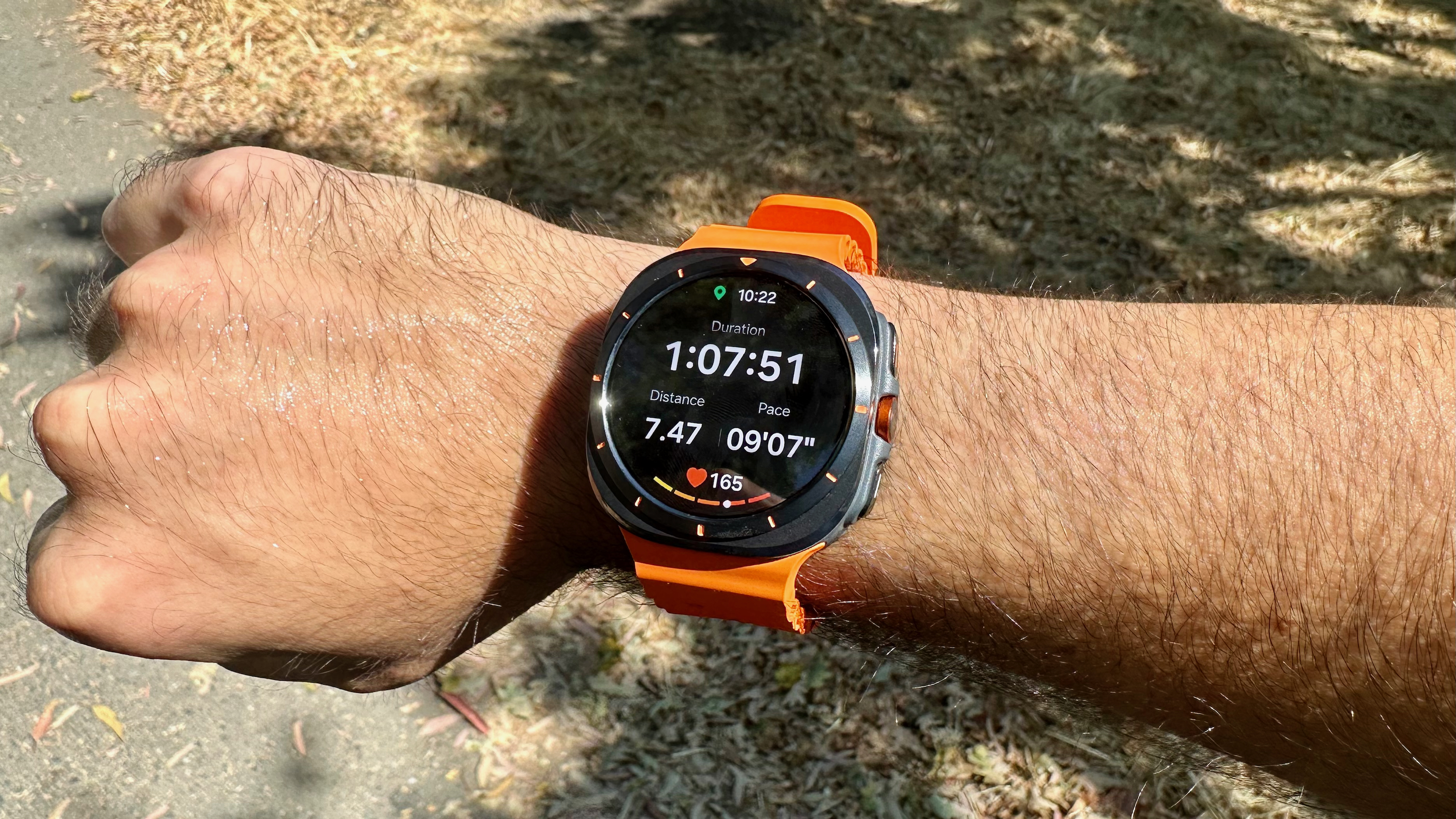
- The Galaxy Watch Ultra's dual-band GPS regularly matches up with Garmin's dual-band tracking.
- Its new revamped HR sensor has extra LEDs and does very well for standard workout tracking, though it can struggle with high heart rates.
Samsung tripled the number of LEDs in the Galaxy Watch Ultra compared to the Watch 6, which it promised would improve accuracy during intense workout activities from 88% to 94%. It also added dual-band GPS, which lets the watch pull your location data from multiple satellite positions to work around any obstructions like buildings or foliage.
Does it make a difference? Health and fitness data was my biggest knock against the Watch 6 when I reviewed it last year. This year, I performed a rapid-fire fitness test and found that the Galaxy Watch Ultra closely matched up against a Garmin watch for GPS accuracy and a dedicated heart rate strap for HR data. It only struggled in one instance: when running an anaerobic track workout at a near-max heart rate.
Since then, I performed a longer test, running with the Garmin Forerunner 965 and Galaxy Watch Ultra on each wrist, both in dual-band mode. In the end, they both had a matching 160 bpm HR average and were only 0.01 miles apart in tracked distance after 9.5 miles. They also deviated by only 1 step per minute for tracked cadence, and their total tracked steps were only 309 apart after over 17,000 steps total.
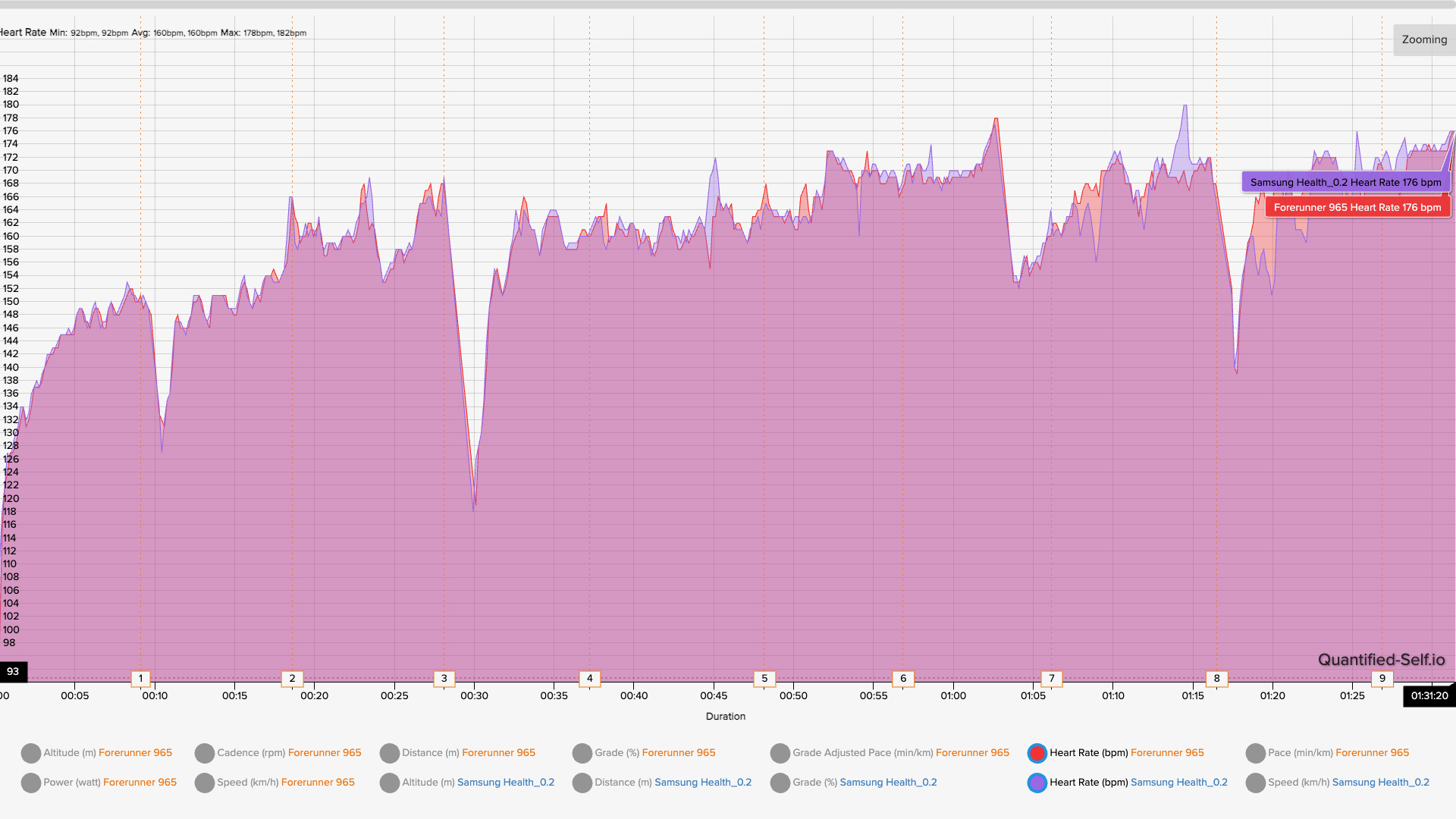
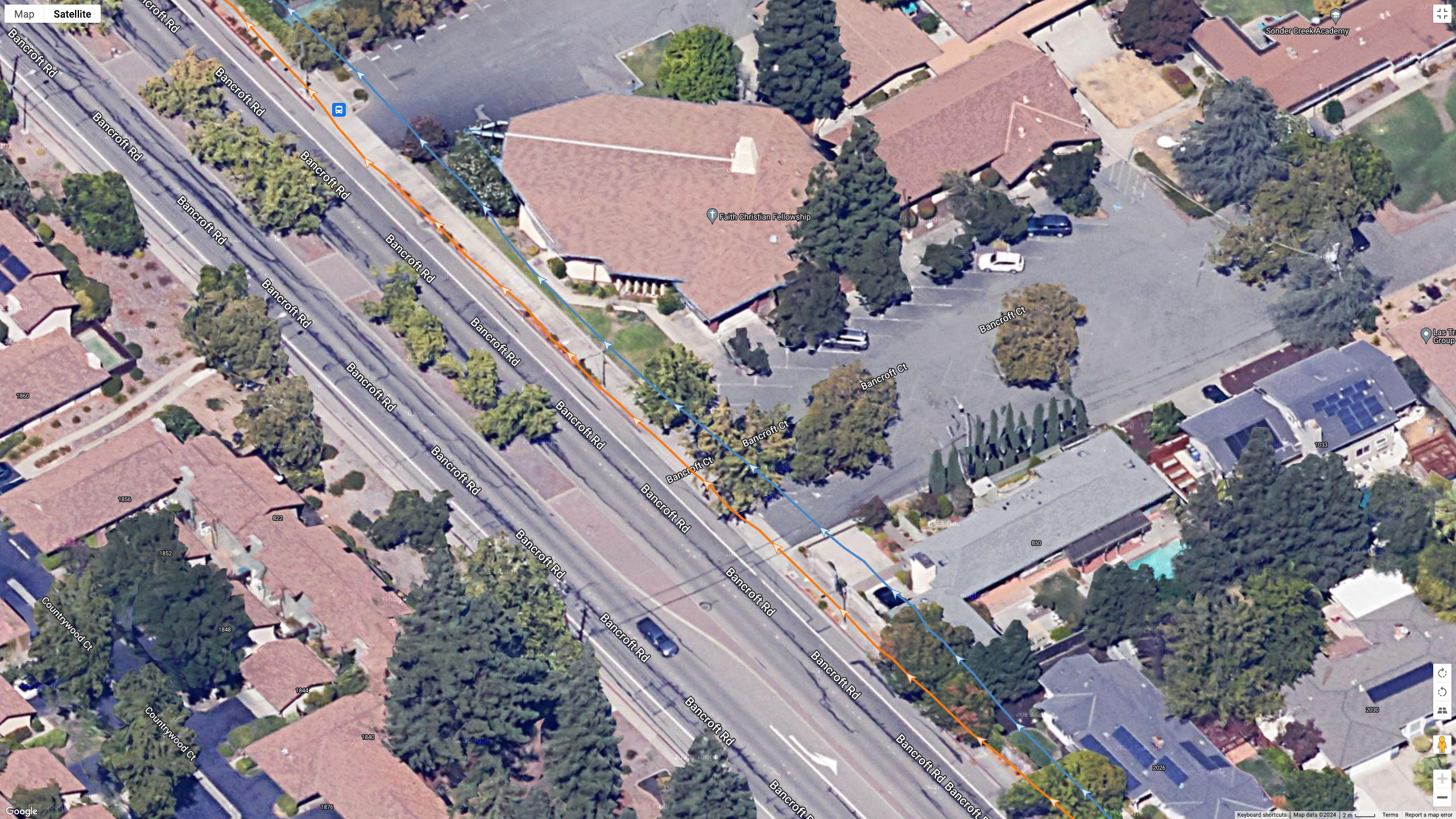

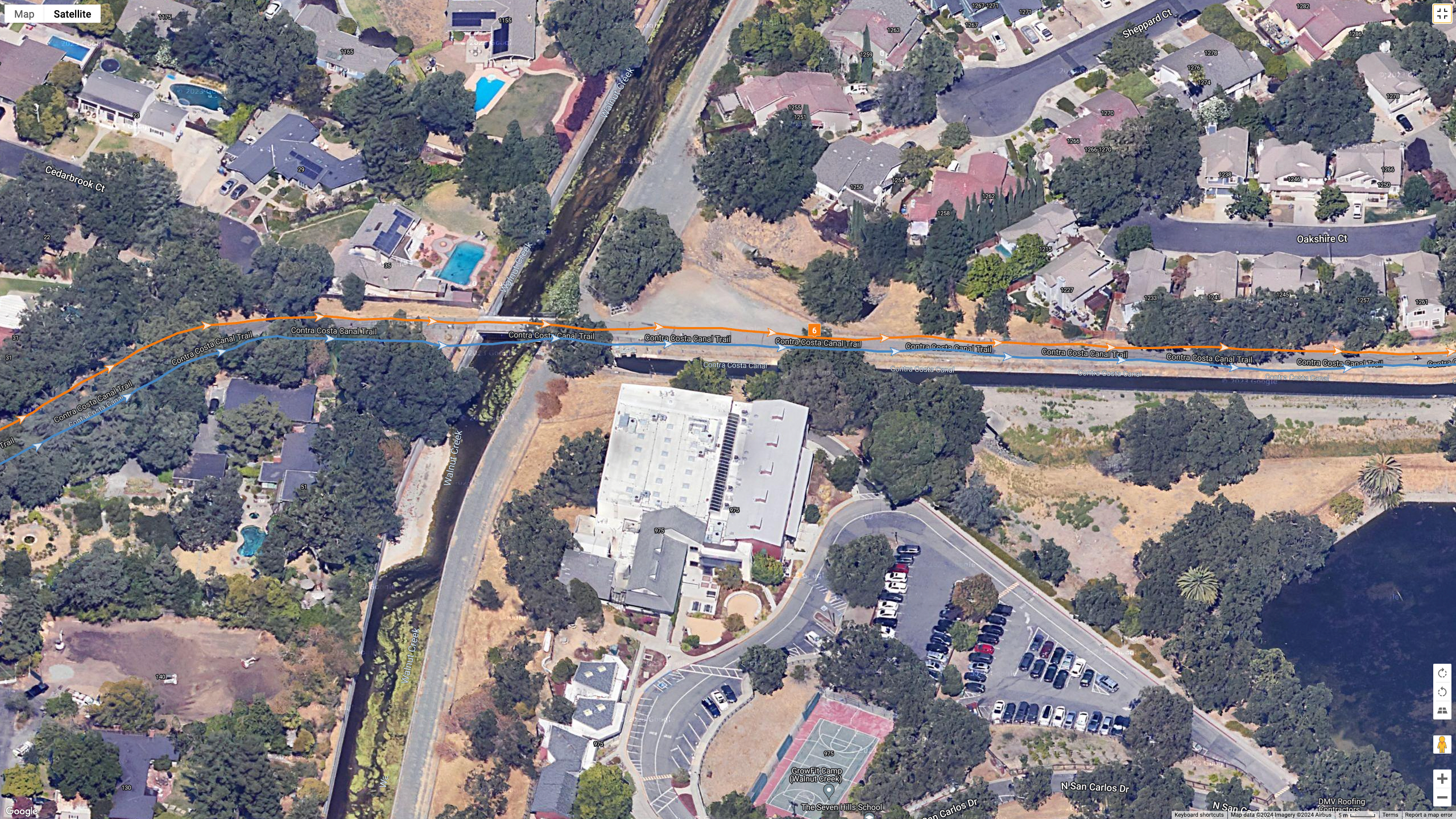
Looking more closely at how they compare, the Galaxy Watch Ultra did start to struggle a bit in the later miles, randomly dipping in moments when I was stepping up my pace, then overcompensating and rising to higher heart rates. It averaged out, but "serious" athletes may want to rely on a dedicated strap for the best results.
In terms of GPS accuracy, Garmin did win the battle; the Galaxy Watch Ultra had mile-long stretches where it showed me off my running path, while Garmin stayed perfect. Practically, though, it didn't matter: the Ultra and Forerunner stayed parallel without the weaving or signal loss the GPS-only Watch 6 had.

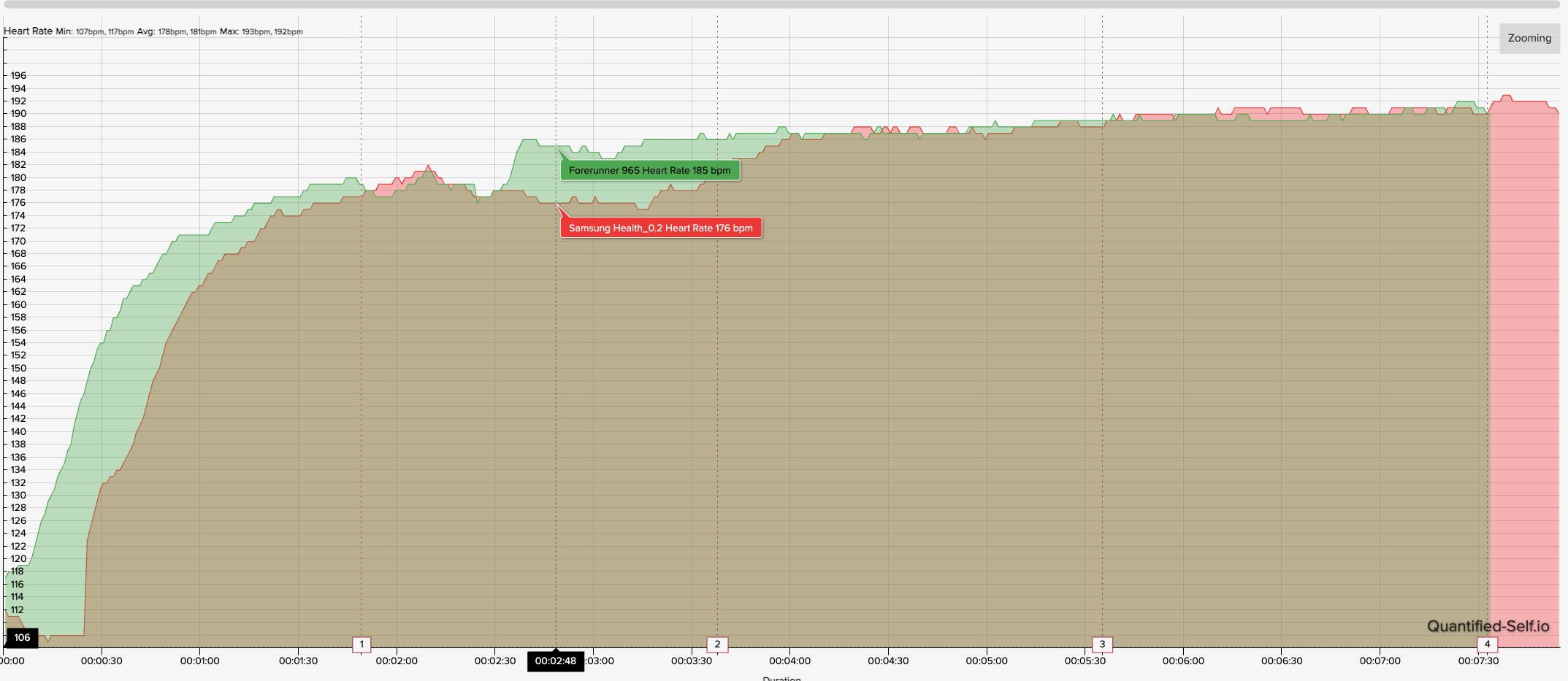
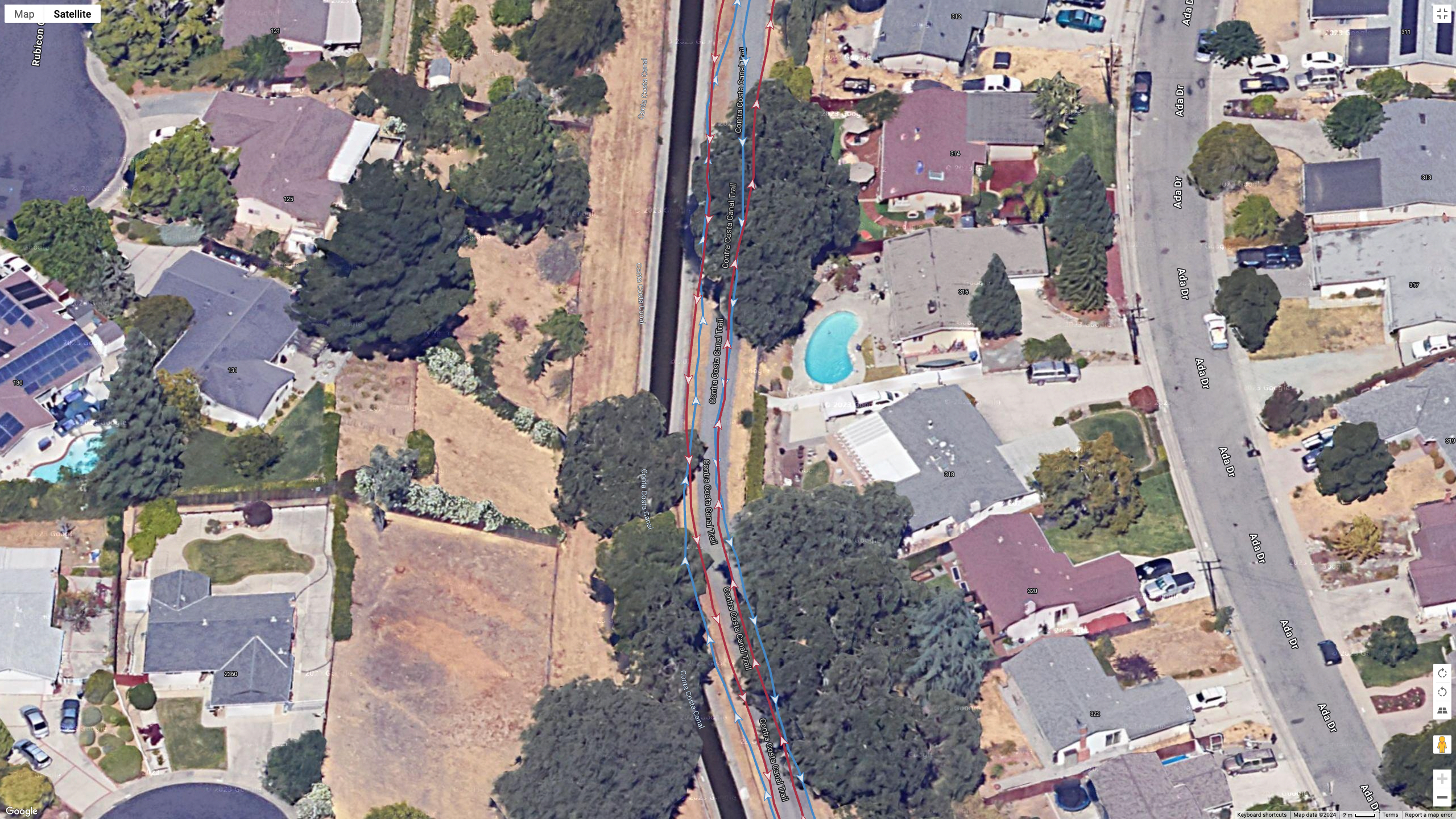
Since my initial review, I performed one more accuracy test for redundancy, pitting the Galaxy Watch Ultra against the Garmin Forerunner 965's GPS and my heart rate strap.
For distance, both watches showed 6.21 miles and a 162 bpm average exactly during my first run. Samsung and Garmin's GPS lines frequently overlapped one another throughout, and the heart rate data closely mirrored the more accurate OHR armband (though still imperfect at times).
For my track workout, I mistakenly started my Samsung workout 30 seconds earlier than Garmin's, which skewed my heart rate average. Taking that into account, the Ultra was mostly on point for that hard mile, but it did have one 30-second span where it struggled to register my 180+ bpm range before catching up.
Overall, the Galaxy Watch Ultra's fitness hardware is much stronger than in previous generations, with its dual-band GPS as a strong point and anaerobic workouts as the only area that needs improvement.
The next step is to improve Samsung Health's rather basic fitness software. Now that both Apple and Google have introduced training load to their respective health apps, it leaves Samsung as the odd company out; its Energy Score is much more focused on the day-to-day, not offering a week-to-week perspective. For now, I'm relying on third-party apps like Strava for those kind of insights.
Samsung Galaxy Watch Ultra: Health and sleep
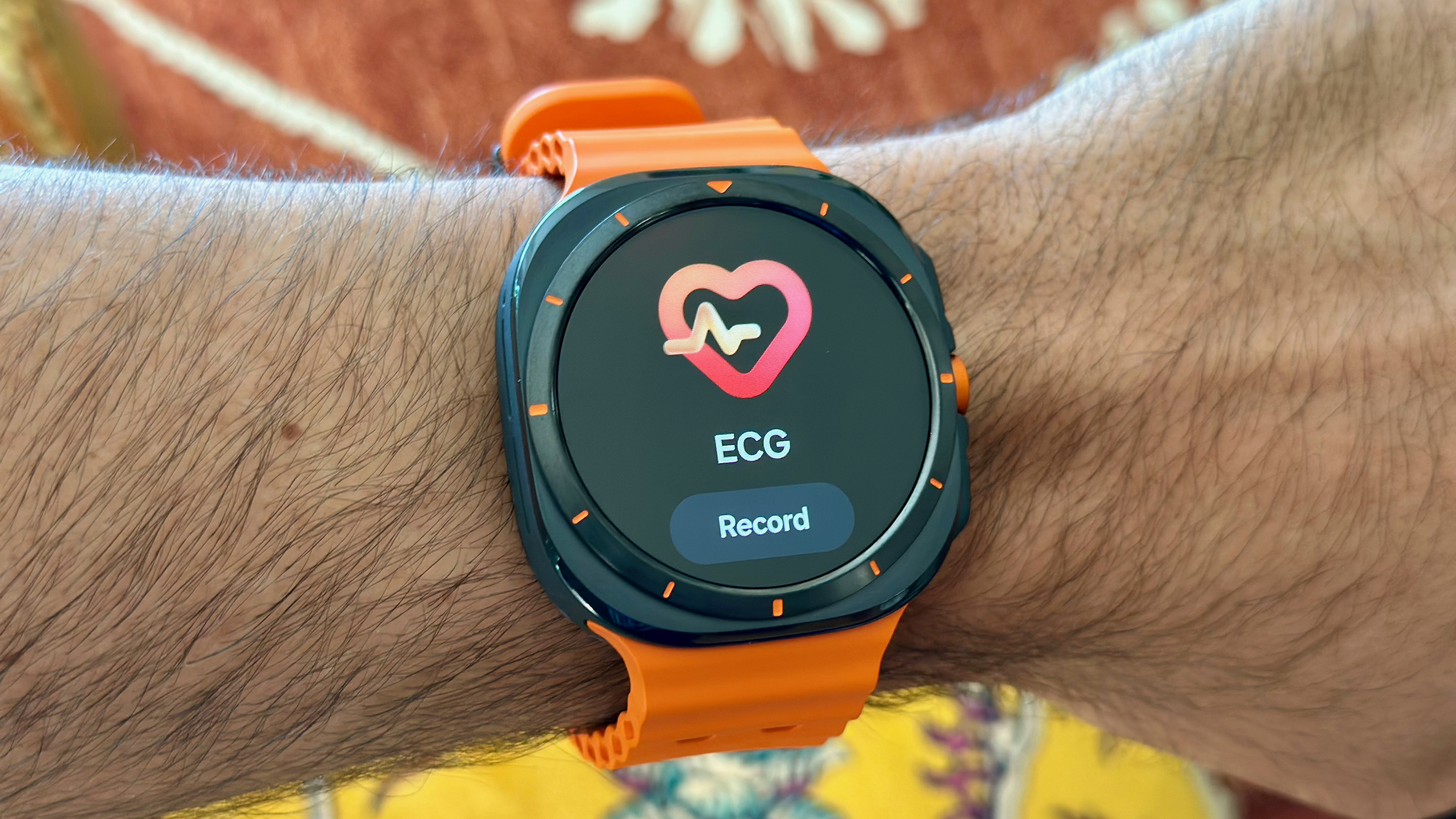
- The new sensor array uses extra LEDs to supposedly offer more accurate readings.
- While the Galaxy Watch Ultra did well for sleep data and HR accuracy in my tests, the SpO2 and BIA sensors were less reliable.
- The newest AGEs Index appears to be all-but-useless.
Most of your Samsung Galaxy Watch Ultra health data comes in a few forms: passive HR and stress data during the day, active ECG readings, and sleep tracking at night with data like blood oxygen (SpO2), skin temperature, respiratory rate, and sleep stages.
I procrastinated on sleep tracking tests before my initial Galaxy Watch Ultra review — I assumed it would be uncomfortable and mess with my sleep — but I finally sucked it up since most of the Ultra's new tricks, like Energy Score and AGEs Index, rely on overnight data. Turns out it's not actually that uncomfortable to wear.
First, the good news: Samsung provides in-depth, accurate sleep data like physical recovery, restfulness, mental recovery, and sleep cycles. The Ultra gave very similar data to my Ultrahuman Ring Air across the board, except that Samsung calculated a higher heart rate variability (HRV).
While sleep tracking is always a bit relative and uncertain, my Galaxy Watch Ultra's daily Energy Score, Stress levels, and resting heart rate all seem to match my real-life energy and typical data on other watches. I had one instance where my resting heart rate while working was unusually high but dropped to proper levels after I cleaned the bottom sensor array; I recommend keeping yours clean for the best results.
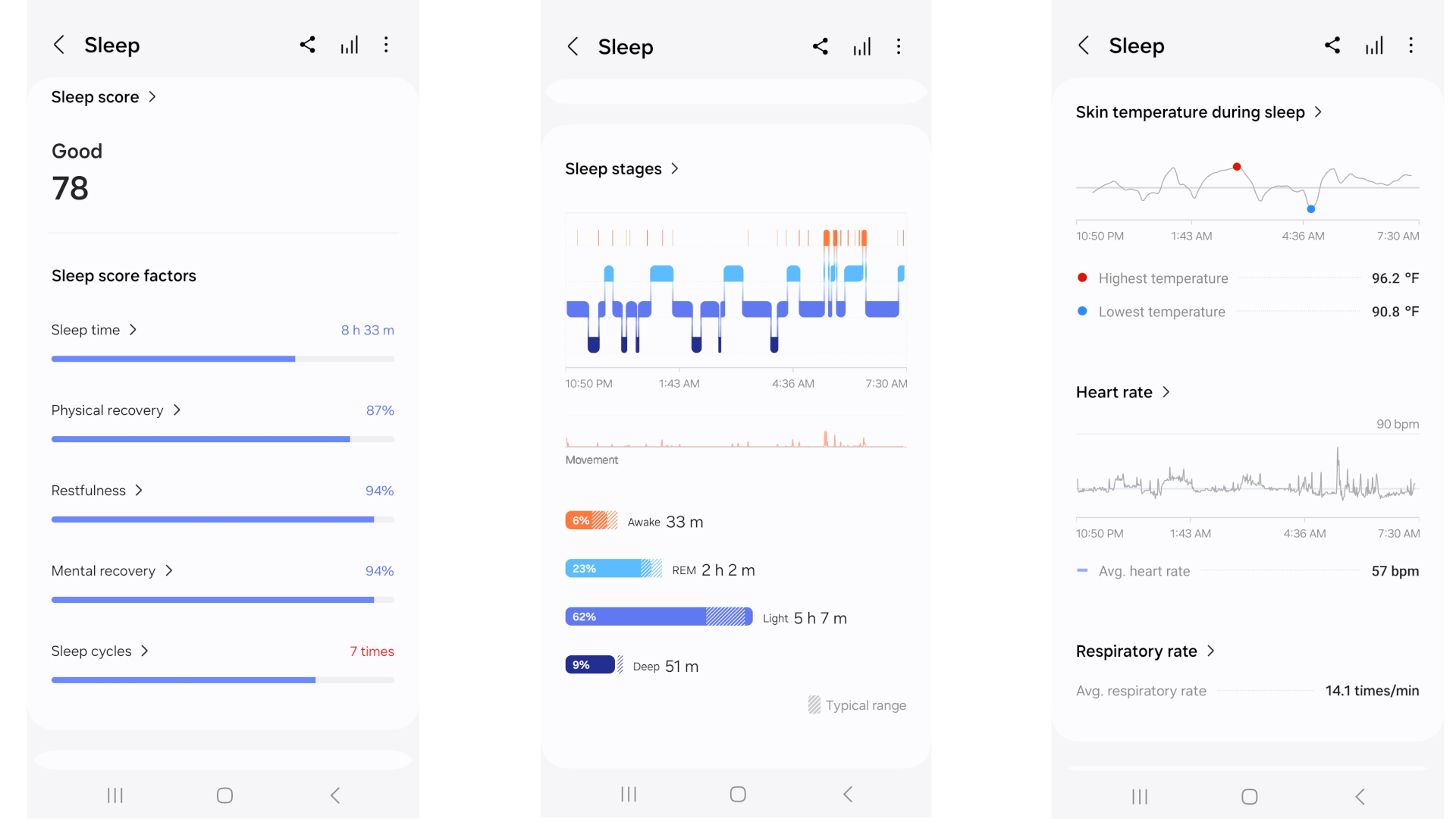
On the flip side, I'm very disappointed with Samsung's vague sensor array upgrades. Both the Galaxy Watch 7 and Ultra have new LED colors — Blue, Yellow, Violet and Ultraviolet — which track new health markers, starting with the advanced glycation end products (AGEs) index tracking. Samsung claims AGEs is just "one of the many new advanced features planned for the next Galaxy Watch."
But if AGEs Index is a sign of what the new Galaxy Watch Ultra LEDs can do, I'm not impressed thus far. At first, I was worried that it showed me a mid-high score, suggesting my bloodstream has excess compounds from a poor sugary diet that signal premature aging and potential health issues. Then I saw that every other Ultra reviewer and a whole Reddit thread all show screenshots with the same score, regardless of each person's health and lifestyle.
It's still a Samsung Labs feature, so I'll accept that it could improve over time. But Samsung waited almost a year to enable skin temperature readings on the Galaxy Watch 5. I don't get why it's making this feature available and stressing people out with fears of diabetes or other issues, when it's not able to differentiate between healthy and unhealthy people.

Just like when I reviewed the Galaxy Watch 5 Pro and Watch 6, I find that the Galaxy Watch Ultra will sometimes show a low blood oxygen range when I wake up in the morning, like "84%–99%." Other times, it shows a more reasonable range like "91–100%," but it's never clear from this range how much time was spent at high or low percentages and whether I have anything to worry about.
Given that no other watches give me readings this low while sleep tracking, I'm leaning towards simply turning this feature off and saving the battery life. At least the temperature sensor seems to be more accurate than it was on previous models.
As a final minor point, I continue to be unimpressed by Samsung's BIA sensor. Last year, the Galaxy Watch 6 measured my body fat percentage, which was about 4% higher than my Withings scale (28 vs. 24%). This year, it has me at 24.7% instead of my current reading of 19.8%, with about 10 extra pounds of fat. I suspect the Ultra's little microcurrents can't reach down to my legs, so the algorithm just extrapolates based on my height and weight.
Samsung Galaxy Watch Ultra: Competition

The Galaxy Watch 7 44mm has most of the same perks as the Galaxy Watch Ultra, aside from its extra durability, battery life, and brightness. You can also buy it with LTE support if that matters. You miss out on the extra battery life, which is a fairly major drawback, and its design is much more basic. In exchange, it weighs (and costs) about half as much and measures 2.5mm thinner.
Looking outside of Samsung watches, the OnePlus Watch 2 and TicWatch Pro 5 are two Android watches with consistent three or four-day battery life, and both cost significantly less than the Galaxy Watch Ultra. They both have their drawbacks, however. The TicWatch has yet to receive Wear OS 4, meaning it still has no Google Assistant, and the OnePlus watch has documented issues with heart rate accuracy.
Then you have the new Pixel Watch 3 45mm. It's quite different from the Ultra, with a much shorter battery life and significantly lighter design, but it also has a fitness focus with a Daily Readiness score and a Cardio Load score that'll appeal to runners. Unfortunately, it doesn't have dual-band GPS, but it does have Google's patented heart rate accuracy.
Samsung Galaxy Watch Ultra: Should you buy one?

You should buy the Galaxy Watch Ultra if...
- Better battery life is your first priority
- You're using an older smartwatch and want a new one that'll last years
- You prefer the Galaxy Watch Ultra style over the Watch 7 (or Watch 6 Classic)
You shouldn't buy the Galaxy Watch Ultra if...
- You're attached to the "Classic" look and bezel controls
- You prefer a lighter smartwatch experience
- You can't afford the Ultra for what it offers
The Samsung Galaxy Watch Ultra is a great smartwatch that's enjoyable to use, adding the hardware changes necessary to make it feel powerful and reliable. Even if serious athletes would probably prefer something like a Garmin Fenix or another fitness watch brand, the Ultra falls in between casual and serious users in an intriguing way.
On the other hand, the Galaxy Watch Ultra isn't all that different from the Watch 7. Its design is a bit polarizing without a physical bezel or crown; both watches have the same fitness updates and MIL-STD-810H standard, and the Watch 7 is more comfortably light. It's fair to say that you're paying for the Ultra's looks, extra button, brighter display, and the convenience of charging it every few days.
If you can get your hands on one for a reasonable trade-in deal, I'd certainly recommend upgrading to the Galaxy Watch Ultra if it looks and sounds appealing. Otherwise, at full price, it might be a tall ask. And given Samsung's path from Pro to Classic to Ultra in the last three years, you might decide to hold out for whatever new smartwatch experiment comes next, Ultra or otherwise!

Revamped but pricey
Ignoring its high price and cheaper Watch 7 sibling, the Galaxy Watch Ultra is a great device that made nearly all of the hardware upgrades I'd have hoped for in a flagship smartwatch. I wish Samsung had given it a working crown and a little more battery capacity to work with, but it's still a great option for anyone that can afford it.

Michael is Android Central's resident expert on wearables and fitness. Before joining Android Central, he freelanced for years at Techradar, Wareable, Windows Central, and Digital Trends. Channeling his love of running, he established himself as an expert on fitness watches, testing and reviewing models from Garmin, Fitbit, Samsung, Apple, COROS, Polar, Amazfit, Suunto, and more.
You must confirm your public display name before commenting
Please logout and then login again, you will then be prompted to enter your display name.
